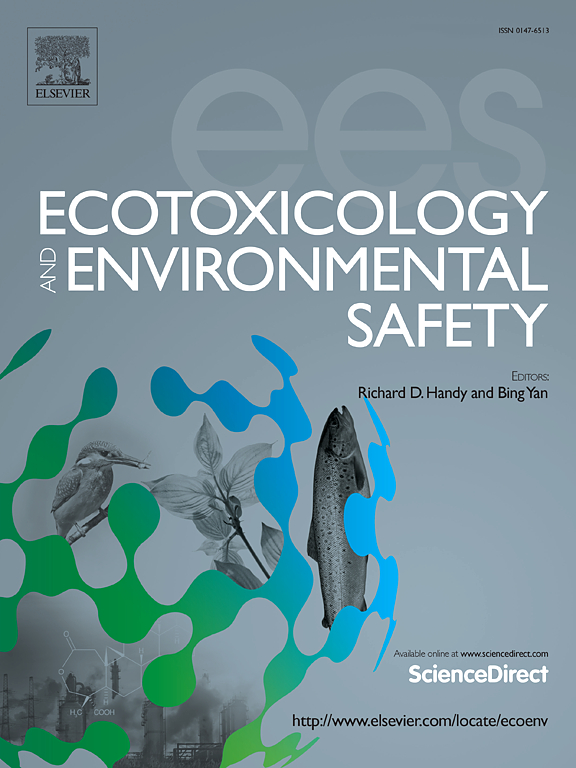Regulation of soil properties by amendments and their impact on Cd fractions and bacterial community structure: Exploring the mechanism of inhibition on Cd phytoavailability
IF 6.2
2区 环境科学与生态学
Q1 ENVIRONMENTAL SCIENCES
引用次数: 0
Abstract
The application of soil amendments is crucial for mitigating cadmium (Cd) phytoavailability in Cd-contaminated paddy fields, thereby promoting safer rice production. However, the mechanisms through which these amendments influence phytoavailable Cd by modifying soil properties have not yet been fully elucidated. A pot experiment was conducted to evaluate the effects of three soil amendments—sepiolite (SE), wollastonite (WO), and a composite (YY)—on the Cd concentrations in brown rice, soil Cd fractions, soil properties, and bacterial community structure. Additionally, the relationships among brown rice Cd concentration, soil properties, Cd speciation, and bacterial diversity were explored. The findings demonstrated that the YY, SE, and WO amendments significantly increased the soil pH, cation exchange capacity (CEC), and concentrations of exchangeable calcium (ExCa), magnesium (ExMg), and available silicon (ASi), facilitating the transformation of water-soluble and acid-extractable forms of Cd into reducible fractions and facilitating the formation of low-solubility Cd compounds, thereby significantly lowering the levels of CaCl2-extractable Cd and DTPA-extractable Cd. The YY amendment also increased available potassium (AK) and available phosphorus (AP) while simplifying the bacterial community structure, notably increasing the abundance of Firmicutes and Bacteroidota. In contrast, SE amendment increased the abundance of Acidobacteriota. Both the YY and SE amendments reduced Cd phytoavailability by modifying Cd speciation and optimizing soil bacterial communities, whereas WO primarily lowered Cd phytoavailability by altering Cd speciation alone. These results underscore the regulatory role of soil amendments in modifying soil properties, influencing Cd speciation, and reshaping bacterial communities, ultimately reducing Cd accumulation in brown rice. This study enhances our understanding of the mechanisms by which amendments alter soil properties to reduce Cd phytoavailability, offering insights for developing in situ passivation technologies for Cd-contaminated soils.
改良剂对土壤性质的调节及其对Cd组分和细菌群落结构的影响:探讨对Cd植物有效性的抑制机制
土壤改良剂的应用对于降低镉污染稻田的镉(Cd)植物有效性,从而促进更安全的水稻生产至关重要。然而,这些改良剂通过改变土壤性质影响植物可利用镉的机制尚未完全阐明。通过盆栽试验,研究了海泡石(SE)、硅灰石(WO)和复合材料(YY) 3种土壤改良剂对糙米Cd浓度、土壤Cd组分、土壤性质和细菌群落结构的影响。此外,还探讨了糙米Cd浓度与土壤性质、Cd形态和细菌多样性之间的关系。结果表明,YY、SE和WO的添加显著提高了土壤pH、阳离子交换容量(CEC)和交换性钙(ExCa)、镁(ExMg)和有效硅(ASi)的浓度,促进了水溶性和酸萃取形式的Cd转化为可还原组分,并促进了低溶解度Cd化合物的形成。从而显著降低了cacl2 -可提取Cd和dtpa -可提取Cd的水平。YY修正还增加了有效钾(AK)和有效磷(AP),同时简化了细菌群落结构,显著增加了厚壁菌门和拟杆菌门的丰度。相反,SE的添加增加了酸杆菌群的丰度。YY和SE均通过改变Cd形态和优化土壤细菌群落来降低Cd植物可利用性,而WO主要通过改变Cd形态来降低Cd植物可利用性。这些结果强调了土壤改良剂在改变土壤性质、影响Cd形态、重塑细菌群落、最终减少糙米Cd积累方面的调节作用。本研究增强了我们对土壤改良剂改变土壤性质以降低Cd植物有效性的机制的理解,为开发Cd污染土壤的原位钝化技术提供了见解。
本文章由计算机程序翻译,如有差异,请以英文原文为准。
求助全文
约1分钟内获得全文
求助全文
来源期刊
CiteScore
12.10
自引率
5.90%
发文量
1234
审稿时长
88 days
期刊介绍:
Ecotoxicology and Environmental Safety is a multi-disciplinary journal that focuses on understanding the exposure and effects of environmental contamination on organisms including human health. The scope of the journal covers three main themes. The topics within these themes, indicated below, include (but are not limited to) the following: Ecotoxicology、Environmental Chemistry、Environmental Safety etc.

 求助内容:
求助内容: 应助结果提醒方式:
应助结果提醒方式:


